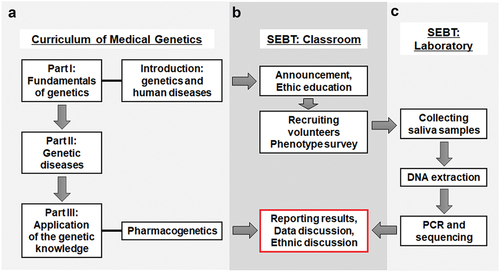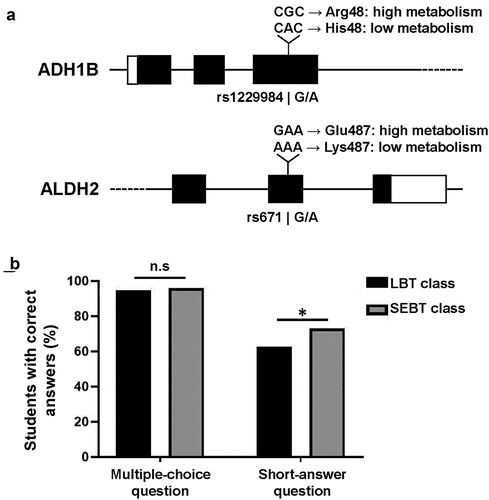Figures & data
Table 1. Current medical genetics curriculum in FMMU.
Figure 1. Diagram of Student Experience-Based Teaching (SEBT). (A) A framework of MG curriculum, which includes 3 teaching parts. SEBT was initiated at Part I and a classroom discussion using SEBT data was carried out at pharmacogenetics unit of Part III. (B, C) Contents of SEBT. The classroom part (B) includes the announcement of SEBT, ethics education, recruitment of volunteers and their phenotype survey, as well as classroom discussion of phenotype and genotype data and related ethics questions. The laboratory part (C) includes sampling, DNA extraction, and PCR-seq experiments of SEBT, which were performed by teaching staff members. The LBT class followed the whole process of this curriculum shown in (A). The SEBT class also accepted the curriculum but were involved in SEBT shown in (B and C). In the pharmacogenetic unit, the SEBT class was given lectures on genetic polymorphism of ADH/ALDH and alcohol tolerance, and discussed genotype and phenotype data from their own samples.

Table 2. Questionnaire about alcohol tolerance.
Table 3. Questions in the final examination.
Table 4. Genotype and phenotype of volunteers.
Figure 2. Performance of students from the LBT class and the SEBT class. (A) Illustration of genetic polymorphism in human ADH1B and ALDH2 genes. Thin lines, open boxes, and filled boxes indicate introns, untranslated regions, and coding regions, respectively. The two polymorphic sites are indicated. (B) Students were given multiple-choice and short-answer questions. Percentages of students with correct answers and incorrect answers are plotted.

